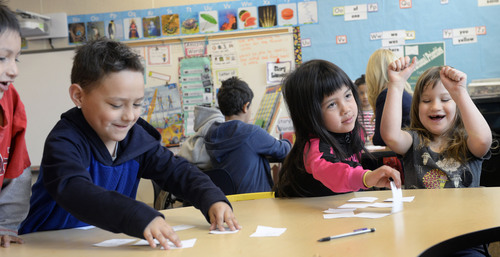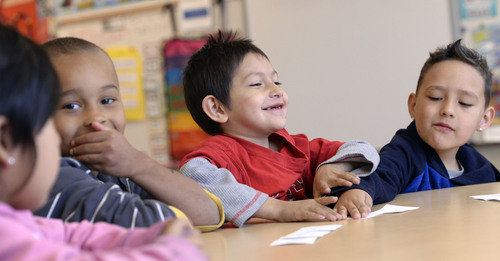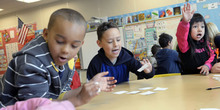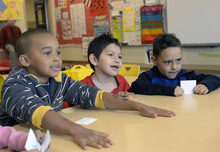This is an archived article that was published on sltrib.com in 2014, and information in the article may be outdated. It is provided only for personal research purposes and may not be reprinted.
In 2011, a family in the affluent Salt Lake County suburb of Holladay drew scorn for starting the biggest measles outbreak in Utah in more than a decade.
The family's unimmunized children imported the virus from Poland after traveling there to retrieve a Mormon missionary.
But public furor has faded, apparently along with support for tightening Utah's exemption law –– one of 19 in the country that allow families to forgo vaccines for personal, and not just medical or religious, reasons.
Meanwhile, the percentage of kindergartners seeking exemptions from Utah's school-entry immunization requirements is creeping up. (See an interactive graphic here.)
School immunization data obtained by The Salt Lake Tribune for the start of the 2013-14 year show 54 of Salt Lake County's 235 public elementary and intermediate schools fell short of the 95 percent vaccination rate experts say prevents measles and whooping cough from spreading — also known as the "herd immunity" threshold.
The anti-vaccine movement is driving more parents to choose not to vaccinate their children, creating hot spots vulnerable to a comeback of vaccine-preventable illnesses, such as measles and whooping cough, public health watchdogs say.
"Each unimmunized person can become a vector for someone else's disease, and thus is a relative danger to the community," said William Cosgrove, a pediatrician in Murray and a member of the Utah Scientific Immunization Advisory Committee.
"It does not require very many," he said, "before you are in a situation where [a] germ can spread to those in the community who can't protect themselves, an infant too young to immunize, or a family member on immunosuppressives, or those few vaccines don't fully protect."
In 1997, 1.2 percent of Utah kindergarteners sought exemptions from immunization requirements. By 2007 it had grown to 2.9 percent, and today it approaches 4 percent.
That's still above the safety threshold set by the U.S. Centers for Disease Prevention and Control (CDC) for preventing the spread of most diseases.
But there are pockets of the state with higher exemption rates, including Summit County (8 percent) and parts of populous Salt Lake County.
—
Protecting the herd • Herd immunity is the theoretical level at which an infection is unlikely to take hold in a community and spread from one vulnerable host to another.
It's a range — 83 to 94 percent for measles and 92 to 94 percent for whooping cough — based on the disease, how easily it spreads and a community's preparedness to combat epidemics.
But anything within or below that range is "flirting with disaster," said Cosgrove, who uses the metaphor of a forest fire.
"If all the trees are healthy and green (wet), a random spark, or even a lightning strike, won't gain purchase. The flames won't spread," he said. But "if, say, every tenth tree is dead or dry, then a spark doesn't have to travel far to find tinder, or a tree that is vulnerable."
Most vulnerable in Utah are schools in better-off neighborhoods. Among the elementary schools with double-digit exemption rates: Draper, Eastwood, Emerson, Hawthorne and Dilworth. Also in that category are several charter schools and Jordan Valley, South Hills and River's Edge middle schools.
This tracks with a national trend of vaccine refusals by the educated and computer-savvy, explained William Schaffner, a professor of preventive medicine at Vanderbilt University. "The problem is access to information, often misinformation through the Internet, rather than access to health care."
One exception in Utah is the Kauri Sue Hamilton School, which has a 22 percent exemption rate and caters to medically vulnerable children, many of whom can't get immunized.
It's those kids who are safeguarded by herd immunity.
"People have an obligation through vaccines to not only protect their child but to protect their frail schoolmates," said Schaffner.
—
A victim of success • Public health officials are still combatting misperceptions about the safety of the MMR vaccine for measles, mumps and rubella following a fraudulent 1998 study linking the vaccine to autism.
The article was found to be a hoax and retracted by the medical journal that published it, but many parents remain unaware of the reversal.
Another perception problem stems from the success of America's childhood immunization program, which is "the most comprehensive in the world," said Schaffner. "Today's parents and grandparents haven't experienced these illnesses themselves, so into this cultural vacuum comes the question, 'Is this necessary?' "
Immigrants from developing countries where contagious disease takes a heavier toll value vaccinations, consumer surveys show.
"It's this cultural heritage, a passing down of information through the maternal line to protect the infant, that sense of understanding, respecting and even fearing these diseases," Schaffner said.
Utah's immunization program manager, Linda Abel, said some parents, faced with their child being shut out of school, will file "convenience exemptions." Obtaining an exemption for personal reasons requires sign-off from a local health department, but for some that's still easier to do than getting a child up-to-date on shots, she said.
Nurses say most exemptions, though, are sought by families philosophically opposed to vaccination.
"The start of each school year gives us a chance to talk about the importance of immunizations, that we feel they're safe and good for kids to have," said Canyons District nurse Martee Hawkins. "But usually by the time parents claim an exemption they've made up their minds."
Often the best means of persuasion is an outbreak.
"During outbreaks we have to send the unvaccinated kids home for their own protection," which hurts kids academically and is inconvenient for working parents, said Jeri Melton, a registered nurse at Jordan District. "And all of a sudden you see kids getting their shots."
—
A perisistent threat • Measles was declared eradicated in the United States in 2000. But it's still common in parts of Europe, Asia, the Pacific and Africa — and remains a leading cause of death among young children worldwide — posing a risk to travelers who aren't inoculated.
And when those travelers return home, the virus easily spreads to other unprotected victims, as Utah's 2011 outbreak illustrates.
The first measles case was traced to Evergreen Junior High, where 4 percent of this year's incoming seventh graders had exemptions, data show.
But because the Evergreen student attended school while infectious, scores of kids — and their siblings, neighbors, parents and coworkers — were exposed.
Nine individuals were infected, 12,000 were exposed and four public schools were placed on quarantine. Costs to monitor and contain the disease exceeded $130,000.
Utah hasn't seen a measles outbreak since, though cases have spiked recently in California, Texas and New York.
Pertussis, or whooping cough, is another matter.
Utah cases of the highly contagious bacterial infection have fallen from a 2012 peak of 1,545. But it comes in waves and never really goes away.
"I think every school district has pertussis outbreaks throughout the year," Hawkins said.
One challenge for fighting pertussis: Findings that the DTaP (diphtheria, tetanus and pertussis) vaccine wears out, a fact that anti-vaccination groups tout as proof that vaccines don't work.
But studies show the five-dose vaccine to be effective in young children and in preteens who receive booster shots at age 11 or 12.
Physicians also now recommend MMR boosters following rare reports of fully vaccinated adults getting the measles.
Even partial protection helps keep symptoms in check and contains the spread, Schaffner said. "No vaccine is perfect, but all vaccines are better than the disease they're trying to prevent."
Twitter: @KStewart4Trib Is your child's school protected?
Find an interactive graphic with the exemption rates for Salt Lake County kindergarten classes here; the data for seventh grade is here. —
Vulnerable schools
Pockets of Salt Lake County families are filing for exemptions from school-entry immunization requirements. Eighteen public schools have double-digit percentages of exempt kindergarteners and seventh graders.
Elementary
Navigator Pointe Academy, Open Classroom, Kauri Sue Hamilton School, Entheos Academy, Emerson Elementary, North Star Academy, Eastwood Elementary, Draper Elementary, Utah Virtual Academy, Hawthorne Elementary, Dilworth Elementary.
Intermediate
Navigator Pointe Academy, Kauri Sue Hamilton Middle School, Open Classroom, Jordan Valley Middle School, River's Edge Middle School, South Hills Middle School.
Source: Utah Department of Health, school immunization tallies for November 2013.













